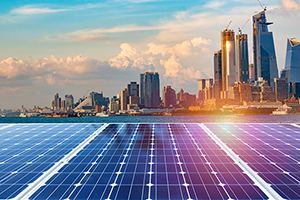The Department of Energy (DOE) Solar Energy Technologies Office (SETO) recently released its Solar Futures Study outlining solar energy’s pivotal role in transitioning to a carbon-free electric grid. The study finds that with aggressive cost reductions, supportive policies, and large-scale electrification, solar could account for as much as 40 percent of the nation’s electricity supply by 2035 and 45 percent by 2050. The ECS community will play a critical role in the technology advances required to make this vision a reality.
Key findings
- Achieving the decarbonization scenarios requires significant acceleration of clean energy deployment.
- Continued technological progress in solar—as well as wind, energy storage, and other technologies—is critical to achieving cost-effective grid decarbonization and greater economy-wide decarbonization.
- Solar can facilitate deep decarbonization of the U.S. electric grid by 2035 without increasing projected 2035 electricity prices if targeted technological advances are achieved.
- The benefits of achieving the decarbonization scenarios far outweigh additional costs incurred for the 2020–2050 study period.
- The envisioned solar growth will yield broad economic benefits in the form of jobs and workforce development.
- Solar can help decarbonize the buildings, transportation, and industrial sectors.
- Diurnal energy storage enables high levels of decarbonization, but additional clean firm capacity is needed to achieve full grid decarbonization.
- Maintaining reliability in a grid powered primarily by renewable energy requires careful power system planning.
- Demand flexibility plays a critical role by providing firm capacity and reducing the cost of decarbonization.
- Developing U.S. solar manufacturing could mitigate supply chain challenges, but different labor standards and regulations abroad create cost-competitiveness challenges.
- Material supplies related to technology manufacturing likely will not limit solar growth in the decarbonization scenarios, especially if end-of-life materials displace use of virgin materials via circular-economy strategies.
- Land availability does not constrain solar deployment in the decarbonization scenarios although land acquisition poses challenges.
- Water withdrawals decline by about 90% by 2050 in the decarbonization scenarios.
- A clean grid requires massive, equitable deployment of diverse, sustainable energy sources.
- Millions of cross-sector jobs will be created by a decarbonized power sector.
- New tools that increase grid flexibility, like storage and advanced inverters, as well as transmission expansion, will help to move solar energy to all pockets of America.
- Significant health and cost savings will be created by a renewable-based grid.
Ubiquitous solar
Solar Futures envisions a future where solar technology is ubiquitous. Photovoltaic technology costs are expected to fall by 50 percent of their 2020 values and capacity factor rises by about 15 percent. The report makes it clear that energy storage improvements are required to enable large-scale solar deployment. The core Solar Futures scenarios deploy hundreds of gigawatts (GW) of storage capacity and assume cost improvements for energy storage due to research, development, and deployment activities. R&D pathways that could contribute to declining costs are described, focusing primarily on those particularly compatible with activities potentially supported by SETO, or via collaboration between SETO and other DOE offices.
Making it a reality
Achieving the Solar Futures Study vision of a larger role for solar in decarbonizing the U.S. electricity system requires long-term policy and market support in addition to sustained advances in solar and other clean energy technologies — the latter being where the ECS community is crucial for success.
For more information, read the full report here.
*Solar Futures Study, U.S. Department of Energy Solar Energy Technologies Office, 2021, pp. xvii-xi, https://www.energy.gov/sites/default/files/2021-09/Solar%20Futures%20Study.pdf



